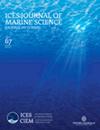Repeated large declines in the Barents Sea capelin population are associated with different ecosystem conditions
IF 3.4
2区 农林科学
Q1 FISHERIES
引用次数: 0
Abstract
Although fluctuations in the biomass of small pelagic fish are strong and rapid, they are largely investigated as individual events or generalized to what is common across several species and populations. The Barents Sea capelin population, which experienced four large decreases in biomass between 1980 and 2016, can be used to compare the similarity of causes and sequence of events leading up to large biomass decline in the same population. Here, we used an age-structured state-space model to investigate the possible contributions from somatic growth, food availability, temperature, predation by Atlantic cod, herring interactions, and/or fisheries on the capelin biomass declines. We recalculated total biomass while perturbing these effects and assessed the change in total biomass. We did not find a single, common cause for the dramatic biomass declines. Although median biomass increased in several of the scenarios, a large decline in total biomass was mostly retained. Atlantic cod predation and food availability influenced adult capelin biomass. Food availability mainly impacted the first period, while the importance of Atlantic cod predation increased from the first period to the third period. Reducing larval mortality from herring interactions or temperature did not suppress the biomass declines. Recruitment failures were maintained due to a combination of process errors and uncertainty in the effect of spawning biomass, and thus fisheries, on age 0 abundance. The impact of each perturbation depended on the specific ecosystem context at the time of the biomass decline.巴伦支海毛鳞鱼数量一再大幅下降与不同的生态系统条件有关
尽管小型中上层鱼类的生物量波动剧烈而迅速,但人们大多将其作为个别事件进行研究,或将其归纳为多个物种和种群的共同现象。巴伦支海毛鳞鱼种群在 1980 年至 2016 年间经历了四次生物量的大幅下降,我们可以用它来比较导致同一种群生物量大幅下降的原因和事件顺序的相似性。在此,我们使用年龄结构状态空间模型来研究体细胞生长、食物供应、温度、大西洋鳕鱼捕食、鲱鱼相互作用和/或渔业对毛鳞鱼生物量下降的可能贡献。我们在对这些影响进行扰动的同时重新计算了总生物量,并评估了总生物量的变化。我们没有发现导致生物量急剧下降的单一、共同的原因。虽然生物量中位数在几种情况下都有所增加,但生物量总量的大幅下降大部分都保留了下来。大西洋鳕的捕食和食物供应影响了毛鳞鱼的成鱼生物量。食物供应主要影响第一阶段,而大西洋鳕鱼捕食的重要性从第一阶段到第三阶段都在增加。降低鲱鱼相互作用或温度造成的幼鱼死亡率并不能抑制生物量的下降。由于过程误差和产卵生物量影响的不确定性,以及渔业对 0 龄丰度影响的不确定性,新陈代谢失败得以维持。每种干扰的影响取决于生物量下降时的具体生态系统环境。
本文章由计算机程序翻译,如有差异,请以英文原文为准。
求助全文
约1分钟内获得全文
求助全文
来源期刊

ICES Journal of Marine Science
农林科学-海洋学
CiteScore
6.60
自引率
12.10%
发文量
207
审稿时长
6-16 weeks
期刊介绍:
The ICES Journal of Marine Science publishes original articles, opinion essays (“Food for Thought”), visions for the future (“Quo Vadimus”), and critical reviews that contribute to our scientific understanding of marine systems and the impact of human activities on them. The Journal also serves as a foundation for scientific advice across the broad spectrum of management and conservation issues related to the marine environment. Oceanography (e.g. productivity-determining processes), marine habitats, living resources, and related topics constitute the key elements of papers considered for publication. This includes economic, social, and public administration studies to the extent that they are directly related to management of the seas and are of general interest to marine scientists. Integrated studies that bridge gaps between traditional disciplines are particularly welcome.
 求助内容:
求助内容: 应助结果提醒方式:
应助结果提醒方式:


